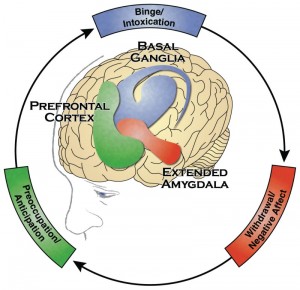ARTICLE OVERVIEW: Addiction is a chronic brain disease. But, what are the reasons why some people get addicted while others not? Major factors that lead to addiction include a person’s unique genetic makeup, their environment, and the person’s psycho-social development. Learn more here.
TABLE OF CONTENTS
- Definition
- Brain Changes
- Stages of Addiction
- How Addiction Occurs
- Why Can’t Addicts Say NO?
- Causes
- Signs Of A Problem
- Statistics
- Your Questions
If you’re reading this, you probably have a friend or family member who is addicted to something: gambling, drugs, alcohol, even sex or the Internet. And you’re probably wondering how did they ever wind up in such a bad place in their lives? So, if you’re asking the question, “Why do people become addicted”, you’re really wondering what causes addiction. And you want to better understand addiction so that you can react better to the person you’re worried about. We hope to help explain addiction basics for you here.
Definition
Most people do not understand the concept of addiction: how and why some people get addicted, and others not. Most often, it is assumed that addicts lack moral principles or they just don’t want to change their behavior. They just don’t want to say NO to drugs. They are too weak to quit.
But, have you ever met a person who wants to become an addict? Have you ever overheard a young a boy or a girl ever say, “I want to be an addict when I grow up?”
Addiction is a complex disease, and ending it takes more than a strong will to stop using substances. This is because addiction is centered in the brain. In fact, scientists are beginning to see addiction as a chronic brain disease that changes the way the brain functions. To this end, the National Institute on Drug Abuse defines addiction as:
“A chronic disease characterized by drug seeking and use that is compulsive, or difficult to control, despite harmful consequences.”
Dr. Maureen Boyle, a public health advisor at NIDA, says: “Addiction is a biopsychosocial disorder. It’s a combination of your genetics, your neurobiology and how that interacts with psychological and social factors.” This means that addiction is like any other chronic disease such as diabetes, hypertension, or asthma, and it can be prevented and treated.
Brain Changes
Substance use hijacks the brain by change its function. How?
There are three key components of the brain involved in substance abuse:
- The basal ganglia: controls the rewarding, or pleasurable effects.
- The extended amygdala: is responsible for causing stress, anxiety, and irritability that typically accompany withdrawal.
- The prefrontal cortex: controls the executive function such as making decisions, ability to organize thoughts , manage time, etc.
These brain areas serve a critical role in helping people to survive. For instance, when people eat, the chemicals in the basal ganglia produce pleasure, and motivate the person to repeat the action. When in danger, the extended amygdala turns on “fight or flight” responses. Drugs effectively change the natural ways that these brain areas work; some functions become exaggerated while others are dulled.
Stages of Addiction
Addiction is a repeating cycle of three stages. Each stage is connected with one of the three brain areas:
1. Binge/Intoxication. The individual is using substances, and experience pleasure (the basal ganglia).
2. Withdrawal/Negative. This stage happens when a person stop using substances, and s/he experience negative symptoms caused by the absence of the substance. The body is under huge stress to get the substance. (the extended amygdala)
3. Preoccupation/Anticipation. The last stage is when the person makes decision to use again, and seeks his/her drug of choice. (the prefrontal cortex)
Find more information on the neurobiology of substance abuse in 2015 Facing Addiction In America: The Surgeon General’s Report on Alcohol, Drugs, and Health here.
How Do People Become Addicted?
Scientists are starting to understand addiction as a brain disease and model it as a chronic relapsing condition. People become addicted to anything first by trying it out. But scientists and researchers think that the brain of an addict is different. They have noticed that the initial decision to take drugs, gamble, binge drink, or overeat is voluntary. But what happens then?
To be honest, researchers, scientists and doctors DON’T KNOW. And they put out theories of addiction to try to explain why addicts continue behaviors that are often very self-destructive. In some models, addiction is strictly a medical condition and is an involuntary result of use. In other models, addiction is the result of emotional and psychological problems. And still other models look to the need to self-medicate for psychiatric conditions.
But what is common among the experience of all addicts is changes in the brain as a result of chemicals or behaviors. Whether or not the brain is predisposed to addiction is still being argued. But most scientists agree that when some people experience a sense of euphoria, pleasure or ease as a result of drugs or behaviors …. and that persons continues the behavior…they can start to change the brain over time.
In particular, many drugs affects the ‘reward circuit’ of the brain by releasing dopamine. This system controls the ability to feel pleasure, and motivates a person to repeat the action that cause pleasure. Simply put, the brain of an addict changes over time and makes self-control and the ability to resist intense impulses (cravings) very, very difficult.
This type of alteration of the brain is most obvious in drug use, when neurotransmitters (the chemical messengers between brain cells) triggered by drugs either:
- Activating nerve cells to send abnormal messages.
- Preventing recycling of brain chemicals.
- Over producing brain chemicals.
The end effect of all of this abnormal brain activity is that the brain of an addict needs MORE chemicals to achieve the same initial euphoria. And addicted brains do not function well. An addict’s judgment, decision making patterns, learning, memory, and behavior control get all out of whack.
Add to that withdrawal symptoms that come from drug dependence…and you have a chemical battle going on in the brain! After continued use of drugs, the brain accepts the presence of the substance as normal. So, when the individual tries to stop using or lowers the dose, the body itself fights to remain its “normal state” by causing withdrawal symptoms. Often, when the substance or behavior is not present, an addict will do almost anything to feel “normal” again.
Why Can’t Addicts Say NO?
It may seem pretty simple to you. If you want to stop being addicted to something, you stop using it. But the good intention to quit a behavior or a chemical substance like drugs or alcohol take more than just good intentions and willpower. The brain needs a break from the self-rewarding and reinforcing pathway that chemical or behavioral addictions create. And this period of “detox”, when the brain seeks its normal state of homeostasis, requires medical supervision.
Causes
We don’t really know what causes addiction. Addiction is a complex disease that affects the physical brain, the psychological mind, and the spiritual self. But scientists look to three major standout reasons for addiction:
1. Biology (nature): Addiction is thought to be influenced somewhat by genes. Genetics make some people more vulnerable to addiction than others. Moreover, the presence of some sort of mental disorder may influence risk for addiction.
2. Environment (nurture): A person’s environment greatly affects whether or not s/he uses or abuses substances or behaviors. A number of different factors influence substance use, including:
- attitudes and beliefs
- family (quality of parenting)
- friends (peer pressure)
- personality traits or characteristics
- physical abuse
- quality of life
- school factors
- sexual abuse
- socioeconomic status
- stress
3. Development (habits): Even though using substances at any age can lead to addiction, it is know that if a person starts using drugs at earlier age, it is more likely they will become addicted. This is risky for teens because parts in their brain that controls judgment, decision making process, and self-control are still developing.
But, anyone can become addicted…
Signs of a Problem
Some of the signs that point to a substance use problem include:
- Neglecting important areas of life (work, home, school responsibilities) for the drug.
- Continued use despite obvious harms.
- Using the drug of choice in larger doses and for a longer period then intended.
- Unable to cut down/or stop even though you want to.
- Spending more time obtaining, using, and recovering from th effects of the drug use.
- Cravings for the drug.
- Experience withdrawal symptoms when drug level drops.
If one or more of these sentences are true, you may need professional help to diagnosis the severity of the addiction. Find more info on diagnosing any addiction in the Diagnostic and Statistical Manual Of Mental Disorders (DSM V) here. Or, seek professional help from any of the following providers:
- A family doctor or general physician.
- A psychologist.
- A psychiatrist.
- A medical doctor trained in addiction medicine.
Statistics
Addiction is relatively common in modern societies. It is roughly estimated that between 8-13% of people living in developed countries experience addiction: whether to food, video games, alcohol, or drugs. In fact, the World Health Organization (WHO) estimates that 5.4 percent of the population worldwide struggles with alcohol and illicit drug use.
In the U.S. the National Survey on Drug Abuse and Health reported that over 22 million people aged 12 or older has a substance use disorder in 2016. The numbers are break down into two main categories: alcohol and drug problems.
- 15.1 million people aged 12+ had an alcohol use disorder in 2016.
- 7.4 million people aged 12+ had an illicit drug use disorder in 2016.
Furthermore, the National Institute on Drug Abuse reported in 2016 startling results: 64,000 drug overdose deaths occurred in 2016.
So, why wait?
Don’t become a statistic.
Seek help for you or a loved one ASAP!
Don’t Hesitate To Ask!
Are you worried about a friend, family or loved one? Please leave your comments and questions below. We’ll do our best to answer them quickly, with qualified and researched based responses.











Related Posts